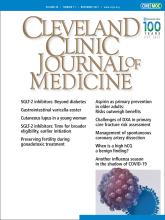ABSTRACT
Dual-energy x-ray absorptiometry (DXA) can detect bone mineral density loss before it can be identified on usual skeletal radiography, making it possible to diagnose osteoporosis in postmenopausal women and older men before clinical fractures arise. However, when DXA is used outside these populations or if the clinical picture does not match the reported T-scores, mistakes can arise in interpreting results and determining the need for pharmaceutical therapy.
- Copyright © 2021 The Cleveland Clinic Foundation. All Rights Reserved.
- Susan Williams, MS, RD, MD, CCD, FACP, FACE
- Angelo A. Licata, MD, PhD, FACP, FACE⇑
- Address:
Angelo A. Licata, MD, PhD, Department of Endocrinology, Diabetes, and Metabolism, F20, Cleveland Clinic, 9500 Euclid Avenue, Cleveland, OH 44195; licataa{at}ccf.org
ABSTRACT
Dual-energy x-ray absorptiometry (DXA) can detect bone mineral density loss before it can be identified on usual skeletal radiography, making it possible to diagnose osteoporosis in postmenopausal women and older men before clinical fractures arise. However, when DXA is used outside these populations or if the clinical picture does not match the reported T-scores, mistakes can arise in interpreting results and determining the need for pharmaceutical therapy.
- Copyright © 2021 The Cleveland Clinic Foundation. All Rights Reserved.






